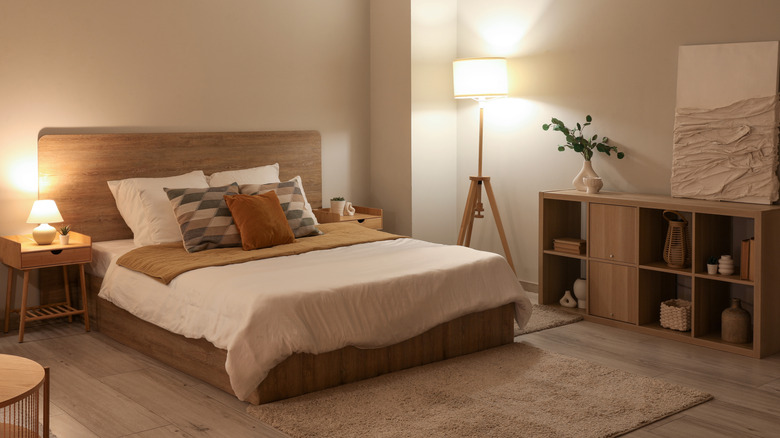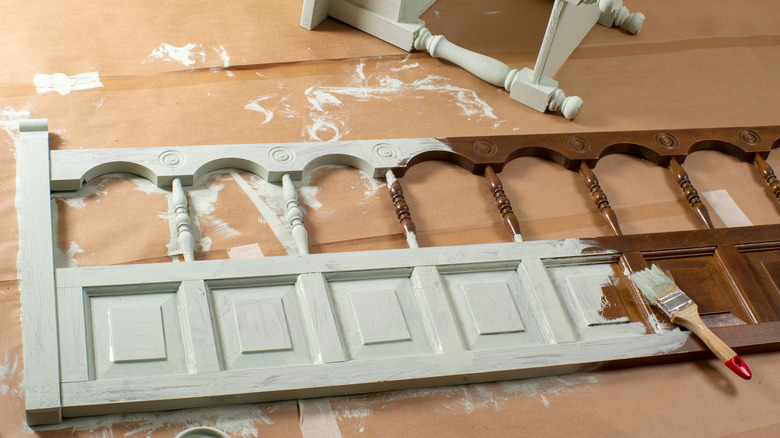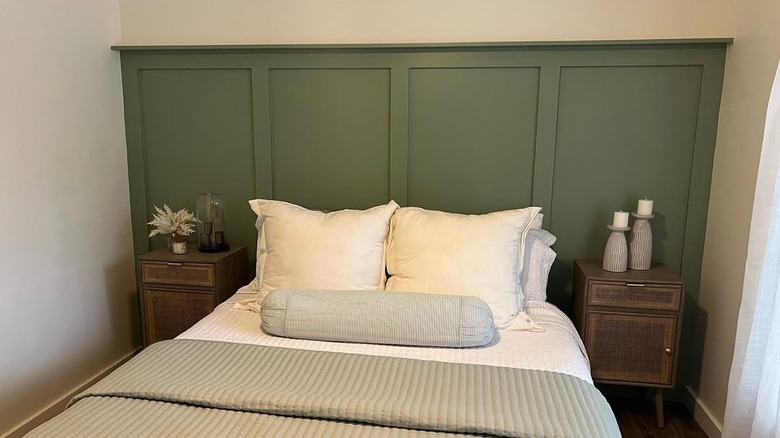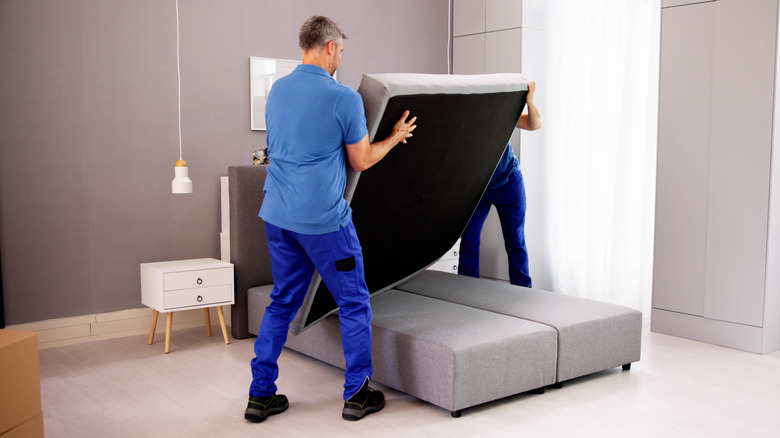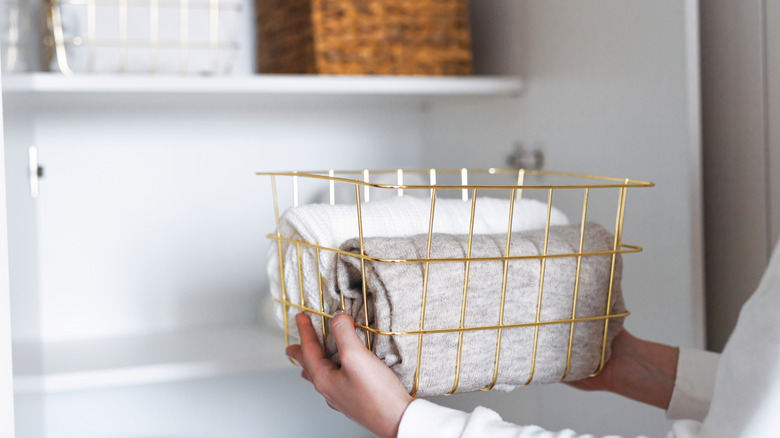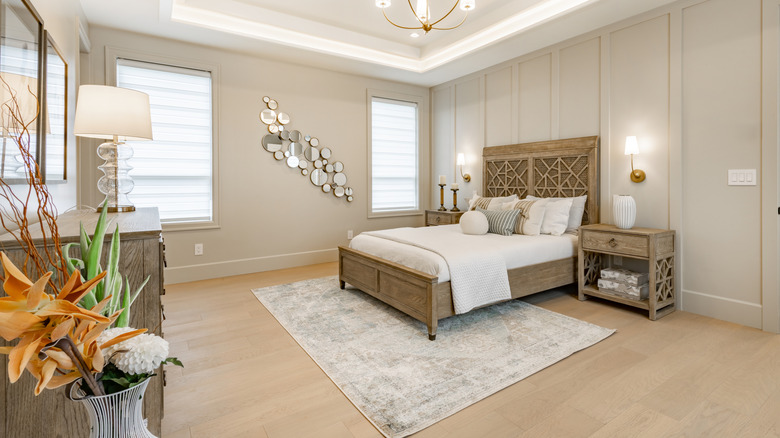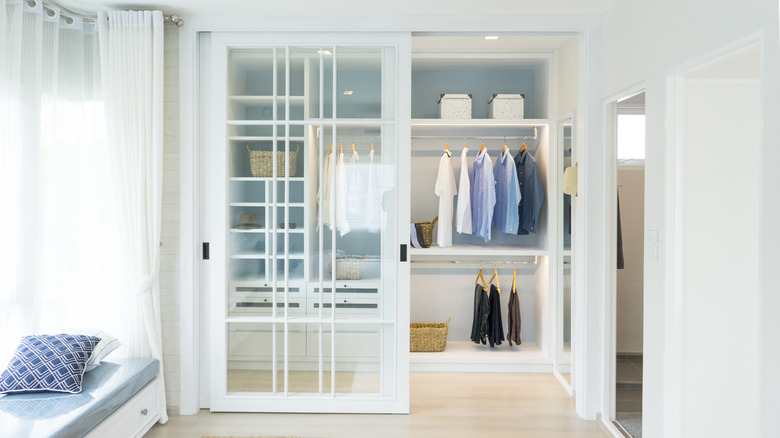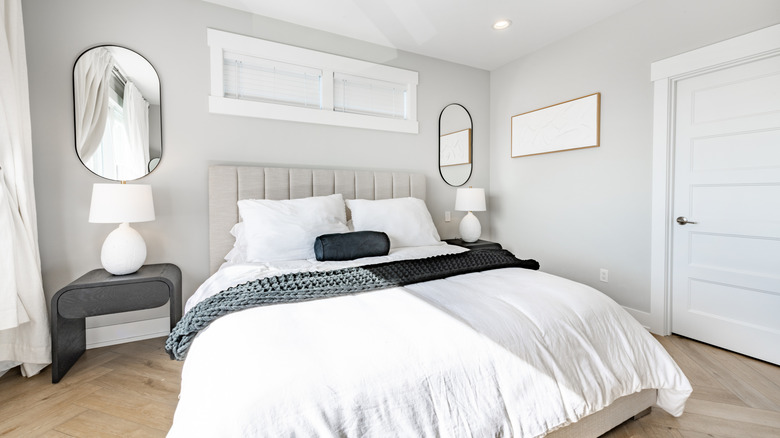16 Simple Bedroom Upgrades You Can DIY In A Weekend
Your bedroom should be your ideal cozy retreat, so why are you falling asleep in a boring space? Kitchens and bathrooms always seem to top the list for renovations, and it makes sense to put money into common areas — but that doesn't mean you should ignore your bedroom. We've rounded up several simple upgrades you can make in a single weekend. They range from very little work, like rolling out a new area rug, to projects that require more sweat equity, like adding a wood detail accent wall.
You can personalize these bedroom upgrades to fit your style and budget. Making one small change this weekend could inspire you to try a few more next weekend. Before you know it, you'll feel like you're drifting off into dreamland in a whole new room. Keeping your budget in mind and selecting projects that fit your skill level make the endeavor rewarding, manageable, and fun, with a good return on investment.
Take some core steps to updating your bedroom's design style
It's easy for bedrooms to just fall together. Say you inherited a dresser when you got your first apartment and added in a new headboard later. Spare decorations from a living room remodel might have migrated into the bedroom without much thought. Outfitting your bedroom bit by bit, as many people do, can lead to a lack of cohesive style. While designing a fully coordinated bedroom overhaul in one weekend is a tall order, you can still take key steps toward creating a harmonious theme with balanced elements.
Reflect on the color palette, style, patterns, and design themes currently in the room. Finding commonalities among the items you love most can help you identify your style, which can then guide your edits of what's in your room to make it more cohesive. Create a mood board to show the design elements you want to keep or expand in your room. A program like Canva lets you easily drop images into a template to create a digital mood board. Refer to the mood board as you make design decisions for your bedroom, like moving in a bookshelf from another room or incorporating an accent color with new throw pillowcases.
Give your old headboard a fresh look with a makeover
Speaking of that headboard you chose years ago, now is the perfect time to give it a creative update. Refreshing a headboard is an easy way to upgrade furniture you already have for a new look, making it a cost-effective option. It's a good solution if you have a sturdy headboard that still serves its purpose but looks a little outdated. The time commitment for this project varies depending on what changes you make, but many options take at least a few hours to complete.
Painting or staining a wooden headboard is an easy makeover — just make sure to clean and sand the wood before refinishing it. If you have access to a saw, you could also modify the headboard itself. Cut off tall posts to create a more modern look, or create an opening in a plain wood panel and cover it with bamboo or lattice. New fabric allows you to change the color, texture, or pattern of an upholstered headboard, and adding buttons for tufting creates dimension.
Create the look of a headboard with paint or artwork
Create a DIY faux headboard to refresh the look of your room without actually buying new furniture. The idea is to give the illusion of a headboard using various materials. This is often a relatively inexpensive project you can do in a few hours, but more intricate options could take most of the weekend. Many alternative headboards are upcycled from various materials you might already have on hand or make use of inexpensive materials like foam board and fabric.
For a simple option, paint the shape of a headboard on the wall, and surround it with wood molding. A similar idea is to cut patterned wallpaper into a headboard shape. For a softer option, install a rod on the wall over your bed, and hang curtains, a quilt, or other fabrics from it. Old doors, shutters, and window frames create a dimensional makeshift headboard. Or, simply cut foam board to shape, and cover it with fabric, wallpaper, or contact paper.
Build a gallery wall to reflect your personality
Artwork is an effective way to convey a theme or tie in your desired color palette, and designing a custom gallery wall creates a curated display of your selected artwork. You may already have wall decor in your home that you can compile into a beautiful, balanced display, making this an inexpensive way to create an impressive focal point in your bedroom. Even if you take your time deciding how to lay out the pieces, you can put together a gallery wall in a few hours.
For an easy gallery wall formula, start with one large anchor piece placed slightly off-center. Add another slightly smaller piece at a distance to create a sense of visual balance. Then, you can add in other pieces of art or decor of varying sizes. To create visual interest, mix it up with different textures, types of art, or unexpected objects, such as textiles, macrame, shelves, baskets, mirrors, or beaded items. A hanging plant adds a natural touch among the art.
Create a cozy reading corner
Your bedroom is the perfect place to create a cozy reading nook in your home. Whether or not you always use it for reading, the corner exudes an inviting and relaxing feeling, which is perfect for your bedroom. Start by choosing the spot for your relaxation area — next to a window offers natural light. If you have a window seat, dress it up with cozy pillows and throw blankets. If not, use that extra accent chair you've been storing, or thrift a cozy seat from a secondhand shop.
Add a side table to hold notebooks, drinks, and other small items (or position the reading nook near your nightstand so it can pull double-duty). A floor lamp, table lamp, or wall sconce supplements natural light, and a small shelf gives you a spot to store books. Finish it off with artwork, a vase of flowers, and decorative accents that make you happy.
Rearrange the layout to improve the flow
On a super tight budget? This bedroom refresher is free! All you have to do is rearrange the furniture you already have. Moving around the pieces in your room gives your brain something new and stimulating to look at. This change provides a fresh perspective on the room you spend so much time in, which could spark creativity and increase your motivation to make changes in other areas. Plus, you might discover a much more functional layout for your bedroom.
There are many tips for rearranging your bedroom, including decluttering first and having a plan. Before actually moving anything, measure your furniture pieces to make sure they'll fit in the new spot you're considering. Start with the bed since it's the largest piece of furniture, and you don't want it to block the flow of traffic in the bedroom. Then, arrange the remaining pieces based on how you use the space.
Build a modern accent wall
Does the mention of an accent wall give you flashbacks to the '90s, when the trend involved nothing more than one boldly painted wall? Well, we have good news for you: Modern accent walls can be chic and offer an effective way to decorate the space above your bed. The cost and time commitment for an accent wall vary based on how you choose to decorate, but many projects can be completed in a weekend. When designing an accent wall, the idea is to create contrast, whether that's through color, pattern, texture, or material.
Wood and trim allow you to create a custom accent wall with dimension. Cover the wall with wood paneling, or create an artistic design by arranging various types of wood trim on the wall. Patterned or textured wallpaper offers a visually interesting backdrop in your bedroom. An alternative is to paint repeating patterns on the wall to give the look of wallpaper without the mess of installation.
Declutter and contain your belongings in decorative storage
Clutter creates a feeling of chaos and is often distracting, which is the last thing you want in your bedroom. Finding simple ways to declutter your bedroom helps you eliminate items that don't contribute to a relaxing environment, potentially lowering your anxiety and boosting your mood. The timeframe for this refresh depends on the size of your bedroom and how much clutter you have. You can typically clean a bedroom in about an hour, but deciding what to keep and toss can take longer.
An easy starting point is removing items that don't belong in your bedroom but have ended up there. Look for duplicates or items you no longer use. Working in sections, such as focusing under the bed or in the closet, breaks the job into manageable chunks and makes it easier to take breaks between areas. Once you eliminate items you don't want, find decorative and functional ways to store what's left. Bins and baskets on shelves are an easy option. Or, install hooks to display hats, purses, and other accessories that you want to show off.
Swap out your bedding for a layered, unique look
Complete bedding sets are straightforward, but they can feel outdated and boring. Plus, you might grow tired of a theme over time, which means you'll have to replace the whole set. Make your bedding more flexible and modern by choosing individual pieces and layering them together. Combining varying elements creates a custom, plush look that you can modify to suit your mood or the season.
Figuring out how to layer a bed isn't as difficult as it sounds. Common items include sheets, a comforter with a duvet, quilts, throw blankets, shams for pillows, and throw pillows. You don't have to include all of those pieces, but doing so creates texture and warmth. Incorporate both solid and patterned pieces to create visual interest, and use a mix of larger and smaller patterns for variation. Limiting it to two or three patterns keeps the setup from becoming too busy. It also helps to include both neutrals and bolder colors for additional contrast.
Update your furniture with paint, detailing, and hardware
If your furniture is out of style but you're not ready to replace it, consider a makeover. This is also a good solution if you have an overly matched set of furniture, especially since furnishing with matching bedroom sets is a common decor practice that's outdated. They make your room look a little too perfect, which drains the personality from the space.
A more stylish approach is to piece together furniture that shares some common features without looking like carbon copies of one another. Modifying the pieces you already have means you don't need to purchase something new — you can also make over thrifted furniture or items from another room that would look good in your bedroom.
Easily change the look of furniture by painting or staining it. If the piece is too plain, add wood trim or dowels to create a fluted look. Swapping the hardware on your dressers is another quick update — choose new handles that fit the current holes and match the style of the furniture.
Bring pattern and texture to the floor with rugs
Area rugs soften hardwood floors, but they also work in carpeted rooms to break up an expanse of monotone fibers with a layered, textured look. This bedroom upgrade is as simple as laying down new rugs or repositioning rugs you already have in the room — the time commitment depends only on how long it takes you to decide on the placement. Knowing the dos and don'ts of styling rugs helps you create a cohesive look on your bedroom floor.
A common option is to place a large area rug under the bed. Positioning it fully under the bed creates an anchored look, but you can create a similar aesthetic with a rug placed halfway or three-quarters of the way under the bed. For example, a queen bed is nicely accented by a 6-by-9-foot or 8-by-10-foot rug. For smaller or interestingly shaped rugs, you can arrange them in your walk-in closet, in front of your dresser, between your bed and television stand, or under a desk or chair.
Incorporate ambient and accent lighting
Lighting is a functional element of your bedroom's design, but it's also a powerful way to change the mood of the space. Incorporating new layers of lighting can make your bedroom feel cozier or more relaxing. You can use it to emphasize architectural features in you bedroom — wall sconces placed on either side of your primary bedroom fireplace are a perfect example. Adding new hardwired fixtures or replacing existing features requires electrical know-how, but there are plenty of other options that don't entail hardwiring.
Adding unique bedside lighting ideas helps brighten up your space to make it functional and comfortable. Bedside lamps, floor lamps, or wall sconces are all good options. Strands of lights draped around the room offer a warm glow when the overhead light is off. For all types of bedroom lighting, choose warm lighting ranging from 2,700 to 3,000K for coziness. Lighting with cooler temperatures can work for a reading nook or desk space, but warmer bulbs are generally better for bedrooms.
Create a cooler, quieter, darker sleep environment
Bedroom makeovers don't have to solely focus on aesthetics. After all, the room is primarily designed for rest. Learning how to design the perfect bedroom for a good night's sleep makes your space more functional. Ideal conditions for sleeping are dark, quiet, and cool. While there are some environmental factors that are hard to modify, you can still make many sleep-related changes in a few hours.
It helps to have a mattress and pillows that fit your firmness preferences and bedding that feels comfortable to you. If you find your bed to be a bit uncomfortable, it may be worth investing in a new mattress topper or fresh sheets. For proper lighting, install room-darkening window treatments (which can also help dampen sounds from outside), and consider dimmer switches or lamps with multiple light levels to avoid harsh light at night. Removing or concealing electronics that have glowing buttons or lights keeps your room dark and reduces the temptation to use devices that could keep you awake. Strategically positioning a fan in your bedroom adds white noise and keeps you cooler — the ideal sleeping temperature is about 60 to 67 degrees Fahrenheit.
Upgrade your closet doors for a functional focal point
Closet doors can take up a large part of your wall, especially if they're sliding or bifold doors. They serve an important function — most of us don't want our clothes on display all the time — but there's room for improvement. Whether you update existing closet doors or install new ones, you can certainly complete the job over the weekend.
If you're on a budget, dress up the doors you have with color, trim, or other accents. If you want the doors to blend in, paint them the same color as the wall or cover both the wall and door in wallpaper. To create an interesting decor element, add squares or rectangles of wood trim on a flat closet door for dimension, or attach mirrors to brighten the space. Replacing closet doors that are in bad condition improves the look and functionality of your bedroom — consider custom doors with glass or other detailing. If new doors aren't in the cards, curtains or a large tapestry are inexpensive and add a soft look to your room.
Add more mirrors and reflective surfaces for increased light and sparkle
A full-length mirror is a must in your bedroom or walk-in closet. If you don't have one already, now is the perfect time to source a freestanding or wall-mounted mirror for checking out your outfits each day. Mirrors can also serve an aesthetic purpose by brightening your bedroom and amplifying natural light. The reflective surfaces highlight your favorite features of the room, adding a sense of depth and emphasizing various textures. Selecting the mirror is often the most time-consuming part of this update — hanging a mirror only takes an hour or less.
Consider the impact of the mirror's shape and frame. For instance, curved frames add a playful or whimsical look, while mirrors with sharp angles feel more sophisticated. Select a frame that fits the room's style, and balance the size of the mirror to be large enough to stand out without overwhelming the wall. When positioning mirrors, note what they reflect to ensure you emphasize positive attributes of the space, and hanging them at eye level is ideal.
Paint the door and trim
You might be surprised at how much a coat of paint on your trim and door changes the look of the room. Painting these areas lets you experiment with color and refresh the space without painting every wall. Lighter trim evokes a softened, open look, while darker trim creates defined borders – both updates lend a refined look that makes your bedroom feel new.
Select a hue based on the room's color scheme and the effect you want the trim to have. Calculate how much paint you'll need — depending on the size of your bedroom (and whether or not you're also painting your door), you may only need a quart of paint, which covers about 100 square feet. Repair and sand the trim and door before applying one or two coats of paint. Each coat typically takes between 30 and 60 minutes once you get the prep done, so even with the prework and drying time, you should only need a day or two to complete this project.
